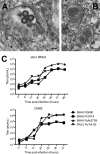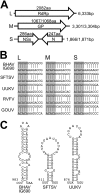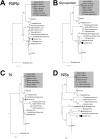Characterization of the Bhanja serogroup viruses (Bunyaviridae): a novel species of the genus Phlebovirus and its relationship with other emerging tick-borne phleboviruses
- PMID: 23325688
- PMCID: PMC3624231
- DOI: 10.1128/JVI.02845-12
Characterization of the Bhanja serogroup viruses (Bunyaviridae): a novel species of the genus Phlebovirus and its relationship with other emerging tick-borne phleboviruses
Abstract
Bhanja virus (BHAV) and its antigenically close relatives Forecariah virus (FORV), Kismayo virus (KISV), and Palma virus (PALV) are thought to be members of the family Bunyaviridae, but they have not been assigned to a genus or species. Despite their broad geographical distribution and reports that BHAV causes sporadic cases of febrile illness and encephalitis in humans, the public health importance of the Bhanja serogroup viruses remains unclear, due in part to the lack of sequence and biochemical information for the virus proteins. In order to better define the molecular characteristics of this group, we determined the full-length sequences of the L, M, and S genome segments of multiple isolates of BHAV as well as FORV and PALV. The genome structures of these Bhanja viruses are similar to those of viruses belonging to the genus Phlebovirus. Functional domains and amino acid motifs in the viral proteins that are conserved among other known phleboviruses were also identified in proteins of the BHAV group. Phylogenetic and serological analyses revealed that the BHAVs are most closely related to the novel emerging tick-borne phleboviruses severe fever with thrombocytopenia syndrome virus and Heartland virus, which have recently been implicated as causing severe acute febrile illnesses associated with thrombocytopenia in humans in China and the United States. Our results indicate that the Bhanja serogroup viruses constitute a single novel species in the genus Phlebovirus. The results of this study should facilitate epidemiological surveillance for other, similar tick-borne phleboviruses that may represent unrecognized causes of febrile illness in humans.
Figures







Similar articles
-
Genetic characterization of Bhanja virus and Palma virus, two tick-borne phleboviruses.Virus Genes. 2012 Oct;45(2):311-5. doi: 10.1007/s11262-012-0785-y. Epub 2012 Jul 18. Virus Genes. 2012. PMID: 22806684
-
Comprehensive molecular detection of tick-borne phleboviruses leads to the retrospective identification of taxonomically unassigned bunyaviruses and the discovery of a novel member of the genus phlebovirus.J Virol. 2015 Jan;89(1):594-604. doi: 10.1128/JVI.02704-14. Epub 2014 Oct 22. J Virol. 2015. PMID: 25339769 Free PMC article.
-
[Molecular-genetic characterization of the Bhanja virus (BHAV) and the Razdan virus (RAZV) (Bunyaviridae, Phlebovirus) isolated from the Ixodes ticks Rhipicephalus bursa (Canestrini and Fanzago, 1878) and Dermacentor marginatus (Sulzer, 1776) in transcaucasus].Vopr Virusol. 2013 Jul-Aug;58(4):14-9. Vopr Virusol. 2013. PMID: 24354060 Russian.
-
Emerging phleboviruses.Curr Opin Virol. 2014 Apr;5(100):50-7. doi: 10.1016/j.coviro.2014.01.011. Epub 2014 Feb 28. Curr Opin Virol. 2014. PMID: 24607799 Free PMC article. Review.
-
Tick-borne viruses: a review from the perspective of therapeutic approaches.Ticks Tick Borne Dis. 2014 Sep;5(5):457-65. doi: 10.1016/j.ttbdis.2014.04.001. Epub 2014 May 21. Ticks Tick Borne Dis. 2014. PMID: 24907187 Review.
Cited by
-
Heartland virus infection in hamsters deficient in type I interferon signaling: Protracted disease course ameliorated by favipiravir.Virology. 2017 Nov;511:175-183. doi: 10.1016/j.virol.2017.08.004. Epub 2017 Aug 31. Virology. 2017. PMID: 28865344 Free PMC article.
-
Generic amplification and next generation sequencing reveal Crimean-Congo hemorrhagic fever virus AP92-like strain and distinct tick phleboviruses in Anatolia, Turkey.Parasit Vectors. 2017 Jul 14;10(1):335. doi: 10.1186/s13071-017-2279-1. Parasit Vectors. 2017. PMID: 28705183 Free PMC article.
-
Transovarial Transmission of Heartland Virus by Invasive Asian Longhorned Ticks under Laboratory Conditions.Emerg Infect Dis. 2022 Mar;28(3):726-729. doi: 10.3201/eid2803.210973. Emerg Infect Dis. 2022. PMID: 35202534 Free PMC article.
-
Isolation and sequencing of Dashli virus, a novel Sicilian-like virus in sandflies from Iran; genetic and phylogenetic evidence for the creation of one novel species within the Phlebovirus genus in the Phenuiviridae family.PLoS Negl Trop Dis. 2017 Dec 27;11(12):e0005978. doi: 10.1371/journal.pntd.0005978. eCollection 2017 Dec. PLoS Negl Trop Dis. 2017. PMID: 29281639 Free PMC article.
-
Development of antibodies against severe fever with thrombocytopenia syndrome virus nucleoprotein for diagnosis.Appl Microbiol Biotechnol. 2025 Jun 7;109(1):139. doi: 10.1007/s00253-025-13530-1. Appl Microbiol Biotechnol. 2025. PMID: 40481890 Free PMC article.
References
-
- Plyusnin A, Beaty BJ, Elliott RM, Goldbach R, Kormelink R, Lundkvist A, Schmaljohn CS, Tesh RB. 2011. Family Bunyaviridae, p 725–741 In King AMQ, Adams MJ, Carstens EB, Lefkowitz EJ. (ed), Virus taxonomy: ninth report of the International Committee on Taxonomy of Viruses, 1st ed Elsevier, London, United Kingdom
-
- Schmaljohn CS, Nichol ST. 2007. Bunyaviridae, p 1741–1789 In Knipe DM, Howley PM, Griffin DE, Lamb RA, Martin MA, Roizman B, Straus SE. (ed), Fields virology, 5th ed Lippincott Williams & Wilkins, Philadelphia, PA
-
- Xu B, Liu L, Huang X, Ma H, Zhang Y, Du Y, Wang P, Tang X, Wang H, Kang K, Zhang S, Zhao G, Wu W, Yang Y, Chen H, Mu F, Chen W. 2011. Metagenomic analysis of fever, thrombocytopenia and leukopenia syndrome (FTLS) in Henan Province, China: discovery of a new bunyavirus. PLoS Pathog. 7:e1002369 doi:10.1371/journal.ppat.1002369 - DOI - PMC - PubMed
-
- Magiorkinis G. 2011. A novel bunyavirus in China. N. Engl. J. Med. 365:864–865 - PubMed
-
- Yu X-J, Liang M-F, Zhang S-Y, Liu Y, Li J-D, Sun Y-L, Zhang L, Zhang Q-F, Popov VL, Li C, Qu J, Li Q, Zhang Y-P, Hai R, Wu W, Wang Q, Zhan F, Wang X, Kan B, Wang S-W, Wan K-L, Jing H-Q, Lu J-X, Yin W-W, Zhou H, Guan X-H, Liu J-F, Bi Z-Q, Liu G-H, Ren J, Wang H, Zhao Z, Song J-D, He J-R, Wan T, Zhang J-S, Fu X-P, Sun L-N, Dong X-P, Feng Z-J, Yang W-Z, Hong T, Zhang Y, Walker DH, Wang Y, Li D-X. 2011. Fever with thrombocytopenia associated with a novel bunyavirus in China. N. Engl. J. Med. 364:1523–1532 - PMC - PubMed
Publication types
MeSH terms
Substances
Grants and funding
LinkOut - more resources
Full Text Sources
Other Literature Sources
Molecular Biology Databases

